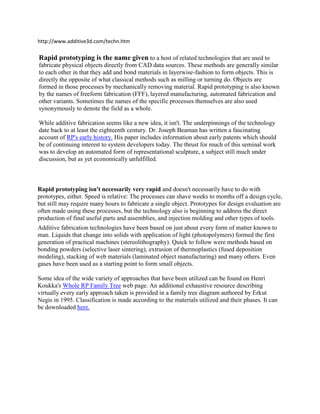Rapid Prototyping
•Télécharger en tant que DOCX, PDF•
0 j'aime•194 vues
Signaler
Partager
Signaler
Partager

Recommandé
Recommandé
In recent years, the use of virtual prototyping (VP) has increased in industry. Nevertheless, the potential of VP in product development has still not been fully achieved in practice. Companies do not necessary know how to use VP technologies and for that reason they are not able to achieve all the benefits. This publication presents the work that has been done by VTT, mainly in the research project called LEFA "New Generation Human-Centered Design Simulators for Life Cycle Efficient Mobile Machines", addressing VP in human-machine interaction design. The purpose is to describe what VP means, what benefits can be achieved, and how companies can use VP in practice. This publication improves the understanding of VP and can be used as a guideline by companies.Virtual prototyping in human-machine interaction design. Susanna Aromaa, Simo...

Virtual prototyping in human-machine interaction design. Susanna Aromaa, Simo...VTT Technical Research Centre of Finland Ltd
Contenu connexe
Similaire à Rapid Prototyping
In recent years, the use of virtual prototyping (VP) has increased in industry. Nevertheless, the potential of VP in product development has still not been fully achieved in practice. Companies do not necessary know how to use VP technologies and for that reason they are not able to achieve all the benefits. This publication presents the work that has been done by VTT, mainly in the research project called LEFA "New Generation Human-Centered Design Simulators for Life Cycle Efficient Mobile Machines", addressing VP in human-machine interaction design. The purpose is to describe what VP means, what benefits can be achieved, and how companies can use VP in practice. This publication improves the understanding of VP and can be used as a guideline by companies.Virtual prototyping in human-machine interaction design. Susanna Aromaa, Simo...

Virtual prototyping in human-machine interaction design. Susanna Aromaa, Simo...VTT Technical Research Centre of Finland Ltd
Similaire à Rapid Prototyping (20)
Digital Fabrication Studio.01 _Fabbing @ Aalto Media Factory

Digital Fabrication Studio.01 _Fabbing @ Aalto Media Factory
Web based e manufacturing of prototypes by using rapid prototyping technology

Web based e manufacturing of prototypes by using rapid prototyping technology
DIGITAL CONSTRUCTION: A Holistic Approach on Continuum Design - Construction ...

DIGITAL CONSTRUCTION: A Holistic Approach on Continuum Design - Construction ...
Digital Fabrication Studio v.0.2: Digital Fabrication and FabLab ecosystem

Digital Fabrication Studio v.0.2: Digital Fabrication and FabLab ecosystem
Virtual prototyping in human-machine interaction design. Susanna Aromaa, Simo...

Virtual prototyping in human-machine interaction design. Susanna Aromaa, Simo...
Design Development Experimental Approach of Industrial Product Enhancement Pr...

Design Development Experimental Approach of Industrial Product Enhancement Pr...
Use of Rapid Prototyping Technology in Mechanical Industry

Use of Rapid Prototyping Technology in Mechanical Industry
LOA seminar 2017 - Product and 3D geometry ontologies at action in constructi...

LOA seminar 2017 - Product and 3D geometry ontologies at action in constructi...
Plus de Suhaimi Alhakimi
Plus de Suhaimi Alhakimi (12)
Rapid Prototyping
- 1. http://www.additive3d.com/techn.htm Rapid prototyping is the name given to a host of related technologies that are used to fabricate physical objects directly from CAD data sources. These methods are generally similar to each other in that they add and bond materials in layerwise-fashion to form objects. This is directly the opposite of what classical methods such as milling or turning do. Objects are formed in those processes by mechanically removing material. Rapid prototyping is also known by the names of freeform fabrication (FFF), layered manufacturing, automated fabrication and other variants. Sometimes the names of the specific processes themselves are also used synonymously to denote the field as a whole. While additive fabrication seems like a new idea, it isn't. The underpinnings of the technology date back to at least the eighteenth century. Dr. Joseph Beaman has written a fascinating account of RP's early history. His paper includes information about early patents which should be of continuing interest to system developers today. The thrust for much of this seminal work was to develop an automated form of representational sculpture, a subject still much under discussion, but as yet economically unfulfilled. Rapid prototyping isn't necessarily very rapid and doesn't necessarily have to do with prototypes, either. Speed is relative: The processes can shave weeks to months off a design cycle, but still may require many hours to fabricate a single object. Prototypes for design evaluation are often made using these processes, but the technology also is beginning to address the direct production of final useful parts and assemblies, and injection molding and other types of tools. Additive fabrication technologies have been based on just about every form of matter known to man. Liquids that change into solids with application of light (photopolymers) formed the first generation of practical machines (stereolithography). Quick to follow were methods based on bonding powders (selective laser sintering), extrusion of thermoplastics (fused deposition modeling), stacking of web materials (laminated object manufacturing) and many others. Even gases have been used as a starting point to form small objects. Some idea of the wide variety of approaches that have been utilized can be found on Henri Koukka's Whole RP Family Tree web page. An additional exhaustive resource describing virtually every early approach taken is provided in a family tree diagram authored by Erkut Negis in 1995. Classification is made according to the materials utilized and their phases. It can be downloaded here.
